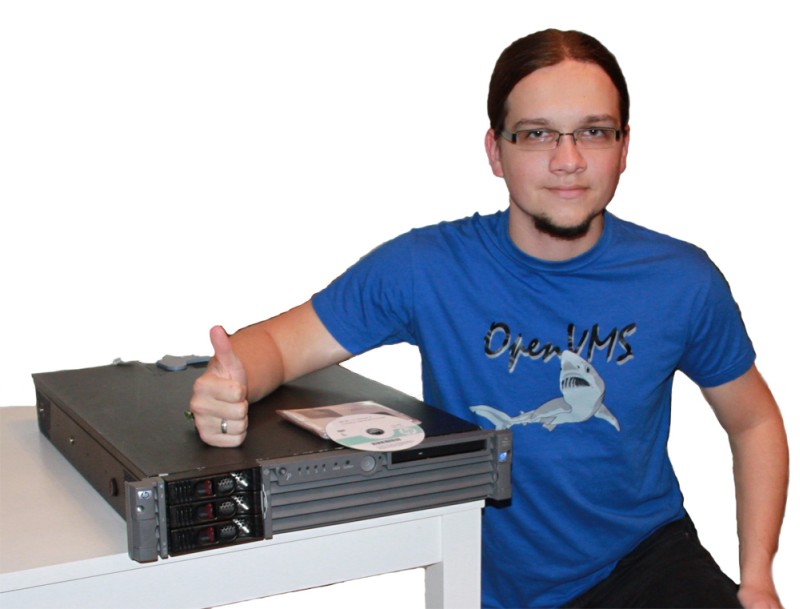- Jahrestag von OpenVMS
HP feiert heute ein ganz besonderes Stück Software-Geschichte - OpenVMS wird heute stolze 35 Jahre alt.
OpenVMS dürfte damit eines der ältesten (wenn nicht sogar das älteste?) immer noch aktiven Betriebssysteme sein. Seit seiner Einführung im Jahr 1977 hat sich einiges getan - anfangs war das früher als VMS bekannte Betriebssystem, das von DEC entwickelt wurde, lediglich auf den hauseigenen PDP-/VAX-Rechnern lauffähig. Als die Nachfrage nach dieser Architektur immer mehr verblasste, sicherte die Portierung auf die modernere Alpha-Architektur das Fortbestehen des Betriebssystems. Nach einigen Jahren wurde DEC von Compaq und anschließend von HP aufgekauft - nach und nach sank auch das Interesse an der Alpha-Architektur. Um langfrisitig Konkurrenzfähigigkeit zu gewährleisten, wurde VMS in OpenVMS umbenannt und auf den von HP promoteten Intel Itanium portiert.
OpenVMS ist ein sehr spezielles, aber immer noch gefragtes Betriebssystem. Es findet genau da Anklang, wo Downtime keine Option ist - wie der Produktslogan schon verdeutlicht. OpenVMS einzigartige Clustersoftware und hohe Stabilität machen das Betriebssystem unter anderem bei Börsen-, industriellen Automatisierungs- und hochverfügbaren Echtzeit-Anwendungen interessant. Zahlreiche Erfahrungsberichte bestätigen das:
- Deutsche Börse über OpenVMS: http://de.openvms.org/TUD2007/HP_DeutscheBorse.wmv
- Erfahrungsbericht der Firma Systemform: http://de.openvms.org/TUD2008/User-Systemform.ppt
- Erfahrungsbericht der Firma Kolbus: http://de.openvms.org/TUD2008/User-Kolbus.ppt
- PDF zum 30. Jahrestag von OpenVMS mit zahlreichen Erfahrungsberichten und Verwendungsstatistiken: http://de.openvms.org/TUD2007/OpenVMS_at_30.pdf
Dank des OpenVMS Hobbyist Programs profitieren nicht nur Firmenkunden von OpenVMS - auch für Bastler gibt es Möglichkeiten, das Betriebssystem näher kennenzulernen. So entstanden auch einige interessante Privat-Projekte, wie beispielsweise:
- Raspberry Pi VAX-Cluster - auf dem Kleinstrechner Raspberry Pi basierendes SIMH VAX-Cluster mit OpenVMS 7.2
- VAX2GO - Linux-basierendes "Instant-Framework" für virtuelle VAX-/OpenVMS-Umgebungen
- FAFNER - privat betriebenes VAX-Cluster mit OpenVMS 7.2. Für Interessierte gibt es kostenfreie Accounts
Ich selbst interessiere mich sehr für exotische Betriebssysteme und bin zufällig auf OpenVMS gestoßen. Dank der Hobbyist-Lizenz ist es mir ermöglicht worden Erfahrungen mit OpenVMS zu sammeln. OpenVMS ist das beeindruckendste Betriebssystem, das ich bisher kennengelernt habe. Die Stabilität und simple Kommandologik ist mir sofort aufgefallen - welches Betriebssystem lässt sich schon mit nahezu einfachem Englisch bedienen? Genau dieser Punkt schreckt viele vor Unix bzw. Linux ab.
Im Rahmen des 35.Jahrestags von OpenVMS war es möglich, persönliche Gedanken und Kommentare an HP zu senden. Natürlich konnte ich Labertasche da nicht nur zuschauen. 😉

I've always been interested in exotic and reliable operating systems. As a Unix and Linux administrator I had to learn the typical Unix-like "command vocabulary" which wasn't always easy for me. Especially when I came from Linux to HP-UX there were plenty of commands which had to be learned like vocabulary.
When I started learning OpenVMS a few months ago things were completely different. I've never seen an operating system which can be controlled using simple english words you would also use for basic communication in a foreign country. Using a small set of about 10 commands you're able to control your personal OpenVMS system - under Linux or Unix you have to know at least about 30 commands to use your system reasonably. Unix is a system which has been developed by plenty of companies - everybody had his own special ideas. You can see this by reading several man pages - similar functions have multiple names in many programs (e.g. sort -k and cut -f). That's something which alienated many people from using Unix or Linux because it is hard to remeber this special names at the beginning. Many information which are obtained by several dedicated statements under Unix or Linux are combined in one OpenVMS command (e.g. SHOW USERS / TIME / NETWORK instead of who / date / ifconfig) - this makes administrating much easier!
DCL makes working on an OpenVMS system even easier. It's so simple to combine special options to a big amount of files using qualifiers and parameters - that makes DCL very special and efficient. To print a couple of files with a different amount of copies you just need a short statement like PRINT A.TXT/COPIES=1,B.TXT/COPIES=2,C.TXT/COPIES=3 - Under Unix I would have chosen three dedicated statements.
I'm using a refurbished HP Integrity RX2600 server for studying HP-UX 11iv3 (I've planned to archive the HP-UX CSA certification) and OpenVMS 8.4 using dual-boot. This system is nearly 10 years old by now and still operational - there was no hardware failure by now. Compared to other server systems I've seen the HP Integrity series is rock-solid like HP-UX and OpenVMS.
Currently I'm working on something which could become a big online project. If I'm achieving success I'd like to switch from Linux to OpenVMS for security and availability reasons. My project makes massive use of Apache, PHP and MySQL - these products can be bundled using WASD VMS Web Services under OpenVMS as well. The possibility to compile Open Source software using GNV opens a wide range of application areas to OpenVMS.
The possibility to get OpenVMS for education and hobbyist purposes without paying licenses is just awesome. Thank you very, very much for this offer, HP! Let's hope for the best for the future of OpenVMS. Keep on advancing this rock-solid product, HP!
Best wishes from germany.
- Christian Stankowic
You know you are running OpenVMS when... ...you enter SHOW SYSTEM and see that your system have been up for almost 5 years.
The best thing about OpenVMS is... ...its great DCL language and commands that are easy to remember.